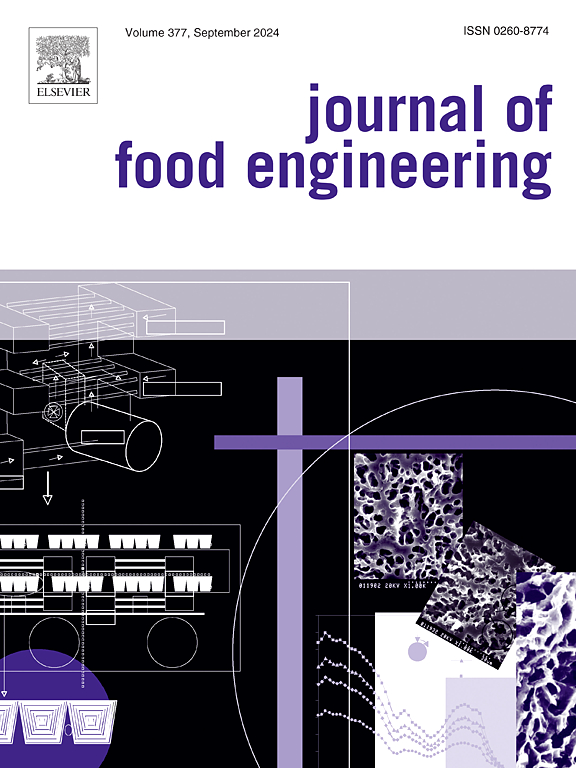Development of red rice germ extract-loaded microcapsules by complex coacervation using alternative proteins and polysaccharide as wall materials
IF 5.8
2区 农林科学
Q1 ENGINEERING, CHEMICAL
引用次数: 0
Abstract
Red jasmine rice germ extract is rich in phenolic compounds, naturally pigmented, hydrophilic, and possesses potent antioxidant properties. However, these beneficial attributes are highly susceptible to degradation by heat and light. This study aimed to microencapsulate the rice extract using a blend of whey protein concentrate (WPC), silkworm pupae protein (SPP), or moringa leaf protein (MLP) with gum arabic (GA) as sustainable wall materials via complex coacervation. The formation of microcapsules at different protein-polysaccharide ratios and pH levels was extensively examined using ζ-potential, turbidity, and coacervate yield analysis. Results indicated that a protein-polysaccharide ratio of 3:1 facilitated optimal complex formation at pH 3.5 for WPC/GA and pH 3.0 for SPP/GA and MLP/GA, primarily driven by strong electrostatic interactions. The encapsulation efficiency of the microcapsules ranged from 40 % to 65 %, with SPP achieving the highest efficiency. The microcapsules were further subjected to in vitro digestion, simulating the oral, gastric, and intestinal phases. Encapsulation significantly enhanced the total phenolic content and antioxidant activity of the rice extract after gastrointestinal digestion compared to the non-encapsulated extract, as confirmed by DPPH, FRAP, and ABTS assays. Notably, microcapsules formulated with SPP exhibited the highest encapsulation efficiency and retained superior antioxidant properties following in vitro digestion.
以替代蛋白和多糖为壁材,复合凝聚法制备红米胚芽提取物微胶囊
红茉莉米胚芽提取物富含酚类化合物,天然色素,亲水性,并具有强大的抗氧化性能。然而,这些有益的属性很容易被热和光降解。本研究旨在利用乳清蛋白浓缩物(WPC)、蚕蛹蛋白(SPP)或辣木叶蛋白(MLP)与阿拉伯胶(GA)的混合物作为可持续壁材,通过复杂凝聚作用对大米提取物进行微胶囊化。微胶囊的形成在不同的蛋白质-多糖比例和pH水平进行了广泛的研究,使用ζ-电位,浊度和凝聚产率分析。结果表明,当蛋白多糖比为3:1时,WPC/GA在pH为3.5、SPP/GA和MLP/GA在pH为3.0时形成的复合物最优,主要由强静电相互作用驱动。微胶囊的包封率为40% ~ 65%,以SPP包封率最高。微胶囊进一步进行体外消化,模拟口腔、胃和肠相。DPPH、FRAP和ABTS实验证实,与未包封的大米提取物相比,包封显著提高了胃肠道消化后大米提取物的总酚含量和抗氧化活性。值得注意的是,用SPP配制的微胶囊在体外消化后具有最高的包封效率和优异的抗氧化性能。
本文章由计算机程序翻译,如有差异,请以英文原文为准。
求助全文
约1分钟内获得全文
求助全文
来源期刊

Journal of Food Engineering
工程技术-工程:化工
CiteScore
11.80
自引率
5.50%
发文量
275
审稿时长
24 days
期刊介绍:
The journal publishes original research and review papers on any subject at the interface between food and engineering, particularly those of relevance to industry, including:
Engineering properties of foods, food physics and physical chemistry; processing, measurement, control, packaging, storage and distribution; engineering aspects of the design and production of novel foods and of food service and catering; design and operation of food processes, plant and equipment; economics of food engineering, including the economics of alternative processes.
Accounts of food engineering achievements are of particular value.
 求助内容:
求助内容: 应助结果提醒方式:
应助结果提醒方式:


